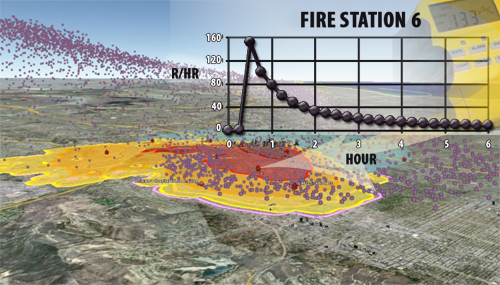Buddemeier trains emergency responders
As inconceivable as it may seem, many lives can be saved in the wake of a nuclear explosion — with appropriate planning and preparedness.
That’s the message that has been delivered to state and local officials, emergency responders and others by LLNL health physicist Brooke Buddemeier, who works in Global Security’s Risk and Consequence Management Program.
Since 2004, Buddemeier has made hundreds of presentations about the value of preparedness in mitigating the impacts of either a nuclear detonation or a "dirty bomb" in a major U.S. city.
Last month, Buddemeier delivered two two-hour talks for a nuclear terrorism response workshop that was held in Los Angeles and hosted by the Los Angeles County Department of Public Health. He also has spoken with officials from Houston, New York City and the Washington D.C. area.
As a part of the U.S. Department of Homeland Security’s (DHS) Improvised Nuclear Device (IND) preparedness program, LLNL — in collaboration with Los Alamos and Sandia national laboratories — is developing simulations specific to Los Angeles and other high threat urban areas for the purpose of addressing a variety of critical response issues.
"The participants considered the DHS workshop to be a tremendous success that energized the preparedness planning process and provided a path forward for developing the Los Angeles regional response plan, which is expected to be a model for the nation," said Kathleen Kaufman, the director of Los Angeles County radiation management.
"The workshop attendees better understand that a response to an IND is possible and that the actions local government takes in the first few hours have the potential to save tens to hundreds of thousands of lives," Kaufman said.
"The county continues to receive positive feedback on the two days’ presentations and believes that the efforts by DHS made a tremendous difference in their understanding of the issues they would confront in the event of an IND attack," Kaufman added.
On the first day of the workshop, Jonathan Fielding, the director of the county’s Department of Public Health, led a discussion with elected officials, department heads and federal agencies.
Among those present were: Los Angeles County Sheriff Lee Baca, who commands the largest sheriff’s department in the United States; City Police Chief William Bratton; City Fire Chief Douglas Barry and others.
The workshop’s second day was attended by more than 150 emergency response personnel, including police, firefighters, paramedics, Coast Guard members and others.
"One goal was to inform elected officials of the impacts of a nuclear detonation in Los Angeles County, and to demonstrate how lives can be saved through appropriate action. We also wanted to work directly with emergency responders, and better understand their challenges and needs in responding to a nuclear detonation," Buddemeier said.
He presented simulations of fallout cloud movement, changes in radiation dose rates and how the emergency response community, the public and health care systems might be affected.
Some of the tips that Buddemeier recommends to state and local governments and emergency responders are:
- Seek shelter from the fallout radiation in the most robust building that is immediately available;
- Stay inside for at least one hour, depending upon conditions;
- Have emergency responders take actions they can perform safely in the early hours of the event to save lives.
These tips are consistent with the recently-released federal report, "Planning Guidance for Response to a Nuclear Detonation."
The DHS IND preparedness program coordinates the efforts of several organizations. LLNL interfaces with state and local governments, and works on fallout modeling and response planning; Sandia National Laboratories/California performs shelter and evacuation analysis; Los Alamos National Laboratory studies infrastructure effects; and the Homeland Security Institute (HSI) works on the communication strategy. Beth Hampton of HSI presented a pre- and post-event public messaging strategy.
The DHS IND preparedness program is run by the department’s Office of Health Affairs. In the 2007 supplemental budget, Congress specified that the office should "ensure consistent and sufficient delivery of information to the public, medical community and first responders for appropriate protective actions to prepare for and respond to a nuclear attack."
In addition to his work with state and local officials, Buddemeier has made presentations to many scientific forums, including workshops in interagency forums, and spoken to prestigious scientific organizations, such as the Institutes of Medicine workshop of the National Academies, the Society for Risk Analysis and the Health Physics Society.
Five other Laboratory employees attended last month’s nuclear terrorism workshop in Los Angeles. They were: Annmarie Wood-Zika, a health physicist in Hazards Control; Michael Dillon, an atmospheric scientist at the National Atmospheric Release Advisory Center; Saverio Mancieri of the Environmental Protection Department; Tom McGrann, an operations research analyst in Global Security; and Joel Swanson of the Radiological Assistance Program.






